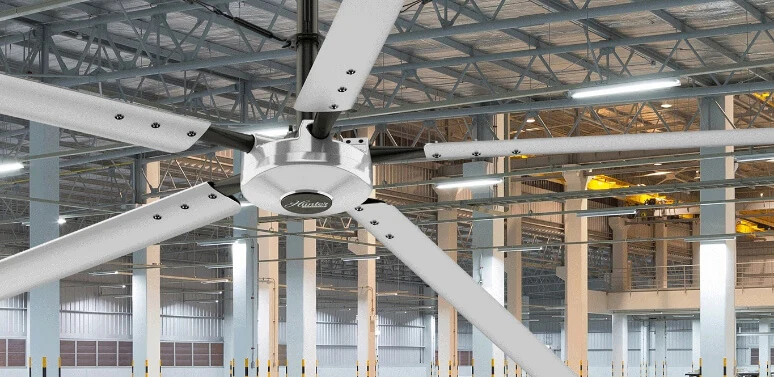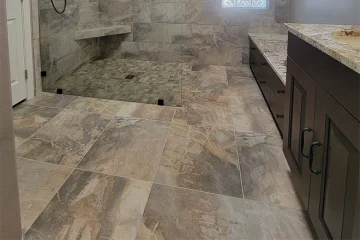In large industrial spaces, maintaining an optimal climate is essential for both comfort and efficiency. One effective solution is high-performance industrial ceiling fans. These strong tools not only improve air flow, but they also help save energy and make the workplace more productive. When selecting an industrial ceiling fan, several key features should be considered to ensure you invest in the right product for your needs. Here’s a comprehensive guide to the top features to look for in high-performance industrial ceiling fans.
1. Blade Size and Design
The size and design of the blades are crucial in determining the efficiency of an industrial ceiling fan. Blades that are bigger usually move more air and work well in large areas like warehouses and factory floors. For optimal performance, look for fans with blade spans ranging from 8 to 24 feet.
Blade design also affects airflow. Fans with aerodynamic blade designs reduce air resistance, leading to better performance and quieter operation. Ensure the blades are constructed from durable materials like aluminium or reinforced composites, which can withstand harsh environments and reduce maintenance needs.
2. Motor Power and Efficiency
The motor is the heart of any ceiling fan, and its power and efficiency directly impact the fan’s performance. High-performance industrial ceiling fans feature robust, energy-efficient motors designed to deliver consistent airflow. Look for fans equipped with high-torque, energy-efficient motors that can handle large spaces without consuming excessive energy.
Variable speed settings are another important consideration. A fan with multiple speed options allows for greater control over airflow, enabling adjustments based on current needs and helping to maintain a comfortable environment.
3. Airflow Capacity
How much air a fan can move is shown by its airflow capacity, which is given in cubic feet per minute (CFM). For industrial applications, a higher CFM is generally preferred as it ensures better circulation in large spaces. Fans with CFM ratings above 10,000 are often suitable for industrial settings.
When evaluating airflow capacity, consider the fan’s efficiency ratio, which is the amount of airflow generated per watt of power consumed. A higher efficiency ratio means the fan provides more airflow for less energy, contributing to overall cost savings.
4. Durability and Construction
Industrial environments can be demanding, so the durability of ceiling fans is paramount. Look for fans constructed from high-quality, corrosion-resistant materials to withstand factors such as humidity, dust, and high temperatures. Metal or heavy-duty polymer blades and housings are ideal for robust performance.
Additionally, consider the fan’s build quality, including features like reinforced brackets and vibration isolation. A well-constructed fan will have a longer lifespan and require less frequent maintenance.
5. Noise Level
In industrial settings, minimizing noise is crucial for a comfortable and productive environment. High-performance industrial ceiling fans are designed to operate quietly, even at high speeds. Look for fans with features like aerodynamic blade designs and precision-balanced blades, which help reduce noise and vibration.
You can also find out about the noise levels of different fan types by reading user reviews and product specifications. Choose fans that are known for being quiet so they don’t disturb the work area.
6. Installation and Mounting Options
Proper installation is key to ensuring the fan operates effectively and safely. High-performance industrial ceiling fans should offer flexible mounting options to accommodate various ceiling heights and configurations. Some models come with adjustable down rods or ceiling mounts that allow for easy customisation.
Additionally, consider the ease of installation. Fans that come with clear instructions and all necessary hardware can simplify the setup process. There may also be professional installation services that can make sure the fan is put in safely and properly.
7. Energy Efficiency and Cost Savings
Energy efficiency is a major consideration for industrial ceiling fans, as they are often used for extended periods. Look for fans that are Energy Star-rated or have high-efficiency ratings. Energy-efficient fans help reduce electricity consumption, which can lead to significant cost savings over time.
Additionally, consider fans with advanced control systems that allow for programming and scheduling. These systems enable you to optimise fan operation based on specific needs, further enhancing energy efficiency and reducing operational costs.
8. Smart Controls and Integration
Modern industrial ceiling fans often come with smart controls and integration features that enhance functionality and convenience. Look for fans equipped with remote controls, wall-mounted switches, or smartphone apps that allow for easy adjustment of settings and speeds.
Some advanced models also offer integration with building management systems (BMS) or Internet of Things (IoT) technology. This integration lets you control and keep an eye on various fans from one place, which helps you better manage airflow and energy use.
9. Aesthetics and Design
While functionality is the primary focus, the aesthetics and design of an industrial ceiling fan can also be important, especially in settings where visual appeal matters. Fans come in many different styles and finishes, so you can pick one that goes with the rest of your industrial room.
Consider factors such as blade colour, fan housing design, and overall appearance. A well-designed fan can enhance the look of the space while still providing high-performance functionality.
Conclusion
Choosing the right high-performance industrial ceiling fan involves evaluating several key features to ensure optimal performance and efficiency. Focus on blade size and design, motor power and efficiency, airflow capacity, durability, noise level, installation options, energy efficiency, smart controls, aesthetics, and warranty. By giving these things some thought, you can choose an industrial ceiling fan that fits the area, makes it more comfortable, and saves you money in the long run.




